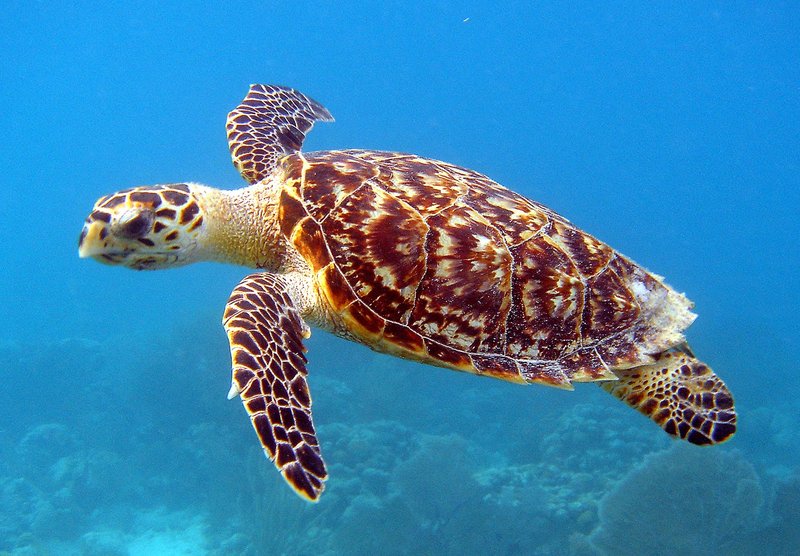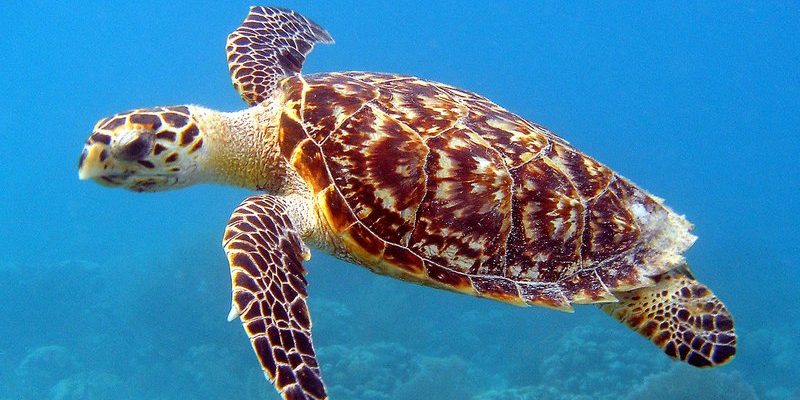
So, how does a hawksbill turtle, with its flippers and instincts, find its way in the big ocean? It’s like trying to find your favorite coffee shop in a new city without a GPS, relying on hints and clues everywhere. Let’s dive into the world of hawksbill turtles and uncover their navigation and communication skills.
Understanding the Hawksbill Turtle
The *hawksbill turtle* is not just another turtle; it’s special. These creatures are often found in tropical coral reefs, where they play a vital role in maintaining the health of these ecosystems. With their striking shells, which have a pattern resembling beautiful amber and dark brown, they’re truly a sight to behold. But their beauty isn’t just skin-deep; their habits and survival strategies are equally impressive.
Hawksbills can weigh between 100 to 150 pounds and reach lengths of about 3 feet. Their unique beak-shaped mouths allow them to feed on sponges, which helps keep reef ecosystems balanced. If you’re picturing a turtle munching on a sponge, it’s a little quirky but essential to their diet!
While they might look graceful in the water, life isn’t all smooth sailing for hawksbills. They face threats from habitat loss, poaching, and pollution. Understanding how they navigate and communicate not only highlights their incredible adaptations but also emphasizes why protecting them is so important.
How Hawksbill Turtles Navigate
You might be wondering, how do they find their way around the massive ocean? Hawksbill turtles use a combination of instinct and sensory cues to navigate through their environment. Just as we might rely on landmarks or the stars when lost, these turtles have some remarkable techniques to stay on course.
One key aspect of their navigation is the Earth’s magnetic field. Hawksbills are known to have magnetic sensitivity, which helps them detect the magnetic pull of the planet. This sensitivity allows them to migrate long distances—sometimes thousands of miles—between nesting and feeding grounds. Just think of them as tiny travelers with an inbuilt compass!
Additionally, they rely on their keen sense of smell to help guide them. When a hawksbill is searching for food or navigating back to their nesting sites, they can pick up on chemical cues in the water. It’s a bit like how we might sniff the air to find our favorite bakery; they can smell where they need to go.
The Role of Scent in Navigation
So, how exactly does their sense of smell work when it comes to navigation? Imagine you’re at a crowded party, and you suddenly catch a whiff of your favorite food—instantly, you know where to go. Hawksbills have a similar ability, as they can detect scents from miles away.
These turtles have specialized receptors in their nasal passages, allowing them to pick up on specific chemicals in the ocean. This ability helps them locate food sources and navigate towards breeding and nesting areas.
Also, the smell of predators and environmental changes can alert them to danger. This acute sense of smell plays a crucial role in their survival, guiding them through both familiar and unfamiliar waters. It’s like having a secret map that only they can read.
Communication Among Hawksbill Turtles
Communication is key in any social species, and hawksbill turtles are no exception. While they might not talk like we do, they have their own ways of expressing themselves. One primary method of communication is through body language.
When mating, males will often engage in displays, such as swimming gracefully around the female and gently nudging her. These movements signal the male’s intent and help establish a connection. Just like when you meet someone new at a coffee shop and share a smile, these turtles express their interest through subtle maneuvers.
Also, hawksbills sometimes use vocalizations underwater. These sounds, which can include clicks or grunts, are not fully understood but are believed to serve as communication signals between turtles, especially during mating season. To us, it might sound like underwater chatter, but to them, it’s a vital part of their interactions.
Why Communication Matters
So, why is it important for hawksbill turtles to communicate? Well, establishing connections is crucial for mating and finding partners. Just like in human relationships, turtles need to connect with each other for breeding success.
Additionally, communication can help with foraging. When a hawksbill spots a good feeding area, it may signal to others in its vicinity, leading to cooperative feeding. They work together, ensuring that everyone gets their share of the nutritious sponges.
This kind of teamwork even extends to avoiding dangers. By communicating through body language or sounds, they can alert each other to potential threats, creating a safer environment for the species. It’s a beautiful example of how even creatures that seem so solitary can engage in social behaviors for survival.
Human Impact on Hawksbill Navigation and Communication
Humans play a significant role in the issues hawksbills face today. From climate change altering their nesting sites to pollution disrupting their natural navigation cues, the balance of their world is shifting.
For example, as ocean temperatures rise, the migratory patterns of hawksbills may be affected. Warmer waters can change the food distribution, impacting their foraging habits. This can lead to a ripple effect, making it harder for them to find food and communicate effectively with others.
Pollution, like plastic waste, can also confuse hawksbills. When they encounter debris in the water, it can disrupt their sense of smell and navigation. Imagine if you were trying to navigate through a foggy city; it would be disorienting! Protecting marine environments and reducing pollution is key to ensuring that hawksbills can continue to thrive.
Preserving the Future of Hawksbill Turtles
So, what can we do to help hawksbill turtles thrive? It starts with awareness and action. Supporting conservation efforts focused on protecting their habitats is essential. By participating in beach cleanups or supporting organizations dedicated to marine life, we can all play a part in preserving their environment.
Additionally, understanding the importance of sustainable fishing practices can help minimize bycatch, which often includes hawksbills and other sea turtles. It’s all about creating a balance where both humans and marine life can coexist harmoniously.
Lastly, supporting laws that protect endangered species can make a difference. Advocacy for stricter regulations against poaching and illegal trade helps secure a brighter future for hawksbill turtles.
The *hawksbill turtle* is a remarkable creature that showcases the wonders of nature. From its incredible navigation skills using the magnetic field and sense of smell to its unique methods of communication, there’s a lot to admire. However, the challenges they face due to human impact remind us of the importance of protecting these beautiful turtles.
As we learn to understand the hawksbill turtle’s world, we also discover how interconnected we all are. Let’s take steps together to ensure that these turtles can swim gracefully in our oceans for generations to come. By raising awareness and taking action, we can make a positive impact and help safeguard the future of these magnificent creatures.

